In May of this year I’d gone on a cruise around the coast of the British Isles to form an opinion of how I felt about going on a cruise by myself. The only other cruise I’d been on was to Alaska with my three daughters 20 years ago. When I was looking for another experience I decided to try a coach tour to a place I’ve been wanting to visit – Northern Ireland – and one that took in Giant’s Causeway. I’d talked to a few people who been to that area and then I found that a friend of mine also wanted to visit that part of the British Isles so we booked a tour with a local company named Moving People.

A taxi came to pick me up directly from my home which solved the problem of carting bags to the railway station in order to join the coach in Blackburn. When the taxi arrived at my home at 6.50 a.m. it was still dark. Shirley was already in the taxi having been picked up at 6.05 a.m! We picked up someone else in Todmorden and then headed to the Hampton hotel in Blackburn where we were served tea and biscuits before we boarded our coach, a 60 seater that was very nearly full. We had been assigned seats but mine was by a window that was totally obscured by metal framework and a curtain so we looked around for a seat with a view and we were fortunate enough to get the back seat where we had a lot more room to spread out, and we kept those seats for the rest of the trip.
We left Blackburn at 8.45 and headed north on the motorway on an overcast but dry morning and we stopped at Lockerbie at 11.15 at a former farmhouse that’s now the Sure hotel, for soup and a sandwich. We didn’t have time to walk to the Lockerbie Memorial Garden but drove past it on the way back to the motorway. It commemorates the bombing of Pan Am 103 in December 1988. 259 people were killed when the plane exploded over the town, a bomb having been detonated by two Libyan intelligence operatives.



Soon after Lockerbie we encountered dense fog and it began to rain heavily as we drove through rolling green hills scattered with sheep. Eventually we passed through an area where I recognised several of the village and town names: Caelaverock, Threave, Newton Stewart and then Minnigaff. Suddenly I remembered staying at Minnigaff Youth Hostel with my parents and school friend Susan. I looked it up in my journal when I got home. And there it was. Yes, we’d stayed there in 1971 and I’ve even got a sketch of the Youth Hostel I made in my journal!

We arrived at the ferry terminal at Cairnryan on Loch Ryan just north of Stranraer at 2.30 in good time for our 3.30 ferry to Belfast only to find that it had been delayed and that meant that our evening meal would now be served at 8p.m. instead of 7. It was going to be a – l o n g day! I was surprised that we stayed on the coach to board the ship, the Stena line.

I thought we’d have to get off the coach and walk onto the ship and pass through some sort of security inspection, but no, we didn’t. It had stopped raining by this time and so we were able to try and brave the promenade deck once we got underway but it really was so windy that it was too difficult to walk, let alone stand upright. it reminded me of a very windy beach in Iceland that I’d braved with Rachel.

We had a snack on the ship during our two hour crossing. It was only 4 p.m. but Shirley and I both said it seemed like bedtime. It felt like it was yesterday that we had set off from home! Looking out from the comfort of the lounge I spotted a large pointed island and knew immediately that it was Ailsa Craig – it was amazing to me that I could remember its name from my 1971 trip!
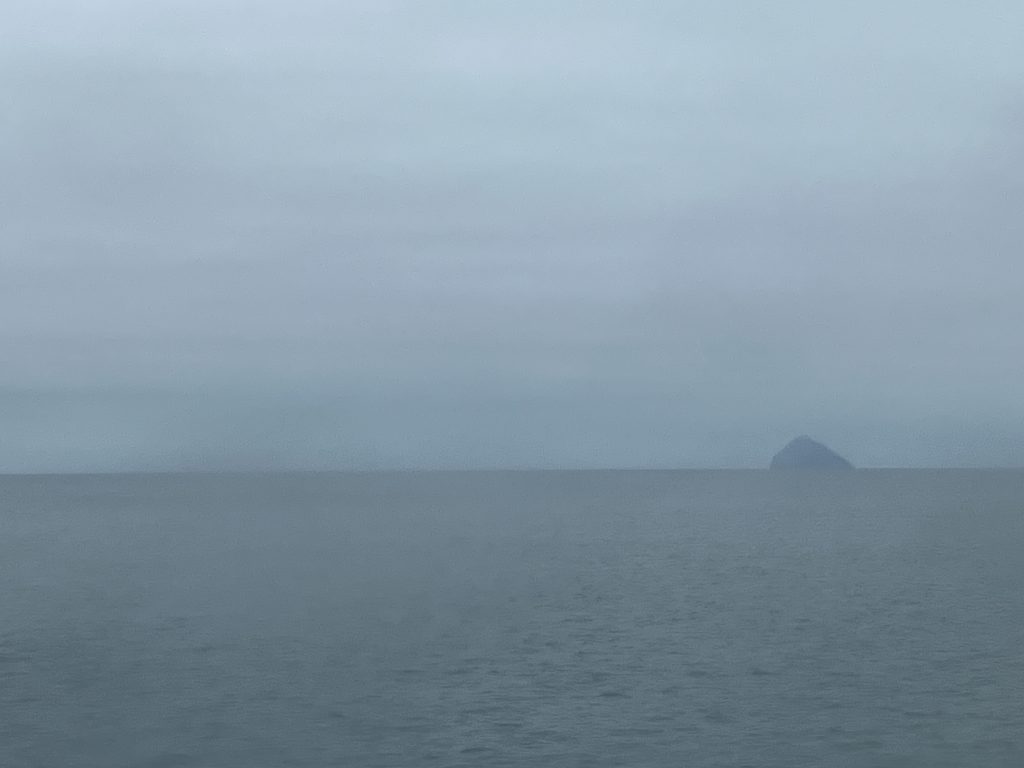
What I didn’t know was that it is an uninhabited island famous for its unique granite which is used to make curling stones and is also a major bird sanctuary for puffins and gannets. It’s a volcanic plug from an extinct volcano and has a lighthouse that was established in 1886 that’s still in operation today though now it’s run on solar power rather than an oil lamp which was first used when Thomas Stevenson designed it. Interestingly he was the father of Robert Louis Stevenson whose Treasure Island I read for the first time recently.
We docked at Belfast harbour at 6 p.m. but we immediately headed north on the freeway and I was disappointed not to have had a few of the city of Belfast. Our hotel was in Coleraine and we didn’t pass through any towns on the 90 minute drive, just fields with cows and sheep and the occasional isolated house. Presumably these were farm houses but they all looked too modern, unlike traditional farmhouses in England. It was dark by the time we arrived at The Lodge Hotel, situated on a traffic roundabout a mile from the town of Coleraine itself.

My room didn’t have much of a view – just a busy road – but it was spacious and clean. I made myself a cup of tea, freshened up a bit and then went downstairs to the dining room. We selected a table where two other members of our tour were sitting. Our tour group had this dining room to ourselves and we were given a menu with five entrees to select from. Dinner was good – melon chunks for starters, an excellent portion of salmon, served with mashed potatoes and garden peas. Dessert was three meringues all smothered in very sweet sauces and cream – far too sweet. I ordered a shandy and tried to think when I last ordered a shandy – probably 20+ years ago – ugh – far too sweet! We struggled to make conversation with the others on our table and we left the dining room as soon as we’d finished dinner – 9.15. I was in bed an hour later and slept well.

Thoughts on life in the coach. Surprisingly there were three men travelling by themselves. Usually I only see women travelling alone. Our driver, Stuart, was very efficient and understanding – it turned out he was a former policeman. There was very little conversation on the coach. Shirley and I were definitely amongst the youngest on the tour and several people had mobility issues. Having not flown I didn’t feel as if I was abroad!
DAY 2
Breakfast was scheduled for 8.45 and departure at 9.50. The decor in the breakfast room reminded me of upstairs at Old Gate in Hebden Bridge with its colourful flowers and birds decorating the wall paper, brightly coloured chairs and lampshades.

There was a choice of hot or cold serve yourself breakfasts. It was raining as we boarded the coach for our hour’s drive to Londonderry/Derry. We took the coast road passing below some amazing cliffs with waterfalls plummeting down a vertical drop onto Downhill beach – Dunne Waterfall.

Entering into Londonderry by crossing the river Foyle the coach parked at the Foyle centre which was well decorated for Halloween.

Our tour guide met us to give us a two hour tour of Derry’s city walls, a UNESCO site, from where we could see the Bogside and in the distance the murals that commemorate the Troubles that devastated this area.


The walls are the most complete example of a 17th century walled city in the whole of Europe, built 1613-1618, and are only 1 mile long. At that time settlers were brought here from England and Scotland in a scheme called the Plantation of Ulster.


Protestants were sent from the city of London’s merchant companies to settle the area which resulted in the renaming of the county to Londonderry in 1613 and the construction of these walls.

Of the many murals the one from the TV series The Derry Girls stood out. I’d never seen the programme but it’s about some teenagers in school during The Troubles. I decided to watch an episode when I got home.

We picked out a good pub, The Bentley, for us to have lunch in, showing off its Halloween decorations in style.
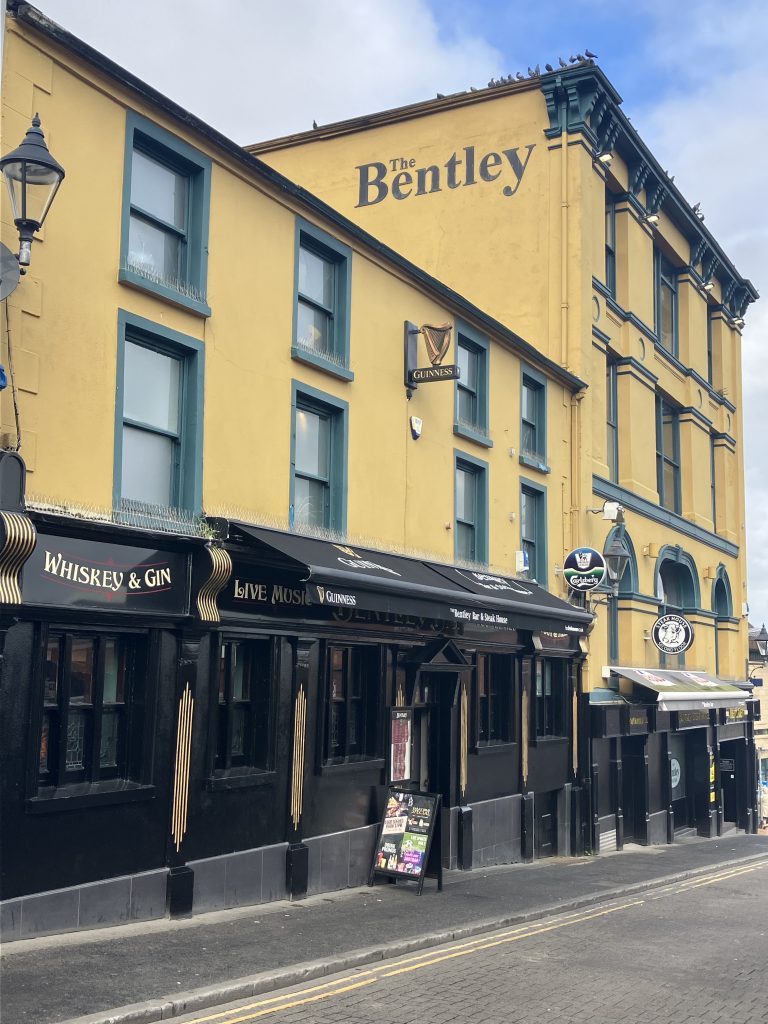

It was the first opportunity we’d had so far on the trip to dine with people from the town itself. We had time to walk across the Peace Bridge and see an imposing statue, unveiled in 2013. It is an 8 foot high statue of a seaman erected to commemorate both Derry’s contribution to the Battle of the Atlantic and all of the allied nations who took part in it. It is a twin of a statue that exists in Halifax, Nova Scotia. After lunch we took a quick nosey inside the City Hall before it was time to board the bus.


We saw a blue plaque on a house, once the home fo Mrs Cecil Frances Alexander (1818-1895) the lyricist of All Things Bright and Beautiful, Once in Royal David’s City and There is a Green Hill Far Away that was supposedly inspired by the view of the surrounding hills from the centre of Derry. Another hymn writer associated with Derry was John Newton (1725) who was born in London and made his name as a North Atlantic slave trader who narrowly escaped death by reaching the Irish shore just before a tremendous storm.

This close encounter with death led him to pray in St Columb’s cathedral and though he returned to the slave trade he eventually gave it up as a result, according to folklore, of an epiphany in the cathedral. He later became a mentor to William Wilberforce whose work led to the abolition of slavery. Newton became a clergyman in 1764 and wrote many hymns to illustrate his sermons, the most well known being Amazing Grace, referring back to his near death encounter.
St Columba is the patron saint of Derry and I’m sorry I didn’t have time to go in the cathedral that’s named after him, especially since he founded the abbey on Iona that I visited in 2018.

Taking our leave of Derry Stuart, our driver, didn’t drive along the coastal route. We were back at our hotel soon after 5 and dinner was at 7 . We were obliged to sit on the same table as the previous evening since we’d submitted our order for dinner by table number. The two ladies had both dressed for dinner, unlike me. My bream was delicious, served with roast potatoes in curry butter, with cabbage and mushrooms. But in addition to this there were several pots of mashed potatoes and chips. When I looked round at the other tables these additional pots of potatoes and veg were hardly touched on any of the tables.

We were all finished by 8.30 and I thought that we might have a game of Set which I’d brought with me, courtesy of Rachel, but we decided to play it another evening so I retired to my room and watched a TV quiz show before bed at 10.
DAY 3
When I woke up I realised I’d fallen asleep last night before I’d checked my online messages so I did that over my morning cuppa in bed and then read another chapter of The Madonna of Bolton, a fascinating book by Matt Cain who is going to give a lecture at the Hebden Bridge Literary and Scientific Society next year. The coach was due to leave at 9.30 and as I crossed the courtyard I became aware that it felt considerably colder than the previous day.
It was only a 15 minute drive to Bush Mills, a village of 1500 people dominated by the huge presence of Old Bush Mill Distillery. But as we drove through the village a poster caught my eye. Surely it was a picture of John Steinbeck. What on earth could he have to do with this village in County Antrim? The poster on the next lamp was C.S Lewis and the next one was a US president. The plot thickened.


I quickly consulted my phone and discovered the connections, but we were immediately due to go on an hour’s guided tour, have lunch at the distillery and then leave on the coach at 2. Yes, I’d have time to head off into the village to look at the posters more closely. But first, our tour of the world’s oldest licensed whisky distillery, founded in 1608, the license being issued by King James I. It uses water from St Columba’s Rill, a tributary of the River Bush. Unfortunately we weren’t allowed to take photos in the distillery. I learned a lot about the craft of making whisky and the various processes involved.



The buildings were rebuilt after a devastating fire in 1885. Much of the whisky produced there goes abroad, much to the USA, and the factory managed to survive the 1920 prohibition there. In 2005 it was purchased by Diageo for £200 million and in 2008 the Bank of Ireland used an illustration of the mills on its bank notes, replacing one of Queen’s university.

The tour guide was excellent and he led us around the huge complex explaining how whisky is made. The barrels are retired after 30 years. Most of the barrels are made in USA. Whisky evaporates which is why ‘old’ whisky is so much more expensive – there’s less of it! Another complete distillery was recently constructed on the site so when one is not working the other one is. Over 100 people work there but the main buildings were not in operation today apart from the bottling unit where a conveyor belt was folding pieces of cardboard into boxes, adding the bottles of whisky and then sellotaping them closed ready for transporting to their destinations worldwide. At the end of the tour there was a whisky tasting opportunity which I forfeited (I’m not a whisky drinker) and headed off into the village to read the posters. Many of the old buildings had been abandoned and some were in ruins – just my cup of tea.


There are 80 listed buildings in the village and it is officially designated a Conservation Village. One large building, now derelict had wood panels blocking the windows and the way they had weathered looked like a wonderful work of modern art depicting woodland, or maybe mill chimneys, a sign post and a fence!



A mural of Steinbeck was painted on the gable end of a building. Steinbeck’s Ulster forebears emigrated to the US in the 19th famine. I sent a photo of the poster to my daughters who were quick to spot two spelling errors on the poster! Salinas, which is close to Santa Cruz, had been spelled without the last S. And ‘his’ had become ‘hs.’ C.S. Lewis was born in Belfast and had visited the ruins of Dunluce Castle as a child and it is said to have inspired his description of Cair Paravel in The Chronicles of Narnia. I was fortunate to drive past the castle ruins later that day. Perched 100ft above the Irish Sea the castle sits precariously on a volcanic crag. It is reputed to date back to the 14th century. In more recent times it was used as the Castle of Pike in Game of Thrones, which I’ve never watched. As to the American president’s connection with Bush Mills it was William McKinley who had ancestors in this area. From the bridge there was a lovely view of the river Bush and a working water wheel from the old corn mill but I needed to hurry back to the coach.

Initially we’d been told that we’d be having lunch at the distillery but there was no cafe or restaurant and it then became clear that our tour was the first on this route.We were guinea pigs. Luckily Stuart came up with the idea of going to Bally Castle, a small seaside town close by.



He’d been there recently on vacation and said we’d be bound to find a cafe or at least somewhere to get an ice cream! It was a beautiful location, right on the beach but with lots of well mown lawns. Shirley and I quickly found a hotel , The Marine, serving lunch and as we sat down our attention was drawn to a wall in the restaurant documenting Marconi’s successful transmission of wireless telegraphy.


In May 1898, Lloyds Insurance of London financed an experimental wireless link to test signal reception at Ballycastle from Rathlin, an island located six miles from Ballycastle. It’s Northern Ireland’s only inhabited island and is noted for its puffin colony. In 1306, the Scottish King, Robert the Bruce, took refuge on Rathlin where he watched a spider persevering again and again to bridge a gap with its web. Eventually it succeeded. Taking heart from the spider’s efforts, he returned to Scotland and eventually regained his crown. That’s an interesting story for me since my first teaching post was at Robert The Bruce school in Bedford! Over 40 shipwrecks are dotted around its coast. I ordered the mussels from the extensive menu. It seemed appropriate to eat seafood when we could actually see the sea from our window seat. After lunch we had half an hour to explore the waterfront and the modern sculptures on the shore line and then we boarded the coach for our trip to The Giant’s Causeway, a place that’s been on my to do list for a long time, and was the main reason that I decided to take this particular coach trip. At first I was disappointed by the number of tourists both in the Visitors’ Centre and on the pathway down to the causeway itself. It was very, very windy but at least it wasn’t raining. I’d imagine that it would be a remote place, spooky even, but there were lots of people everywhere – on the various paths, climbing onto the rocks, posing for selfies on the cliffs and standing in a queue waiting for the bus that links the Visitors’ Centre with the causeway. However, I got over my initial disappointment and found myself in awe of the volcanic rock formations.


I didn’t feel confident enough to climb onto the rocks themselves – far too uneven and slippery. One challenging path led to the outcrop of rocks high on the cliff face and is called the organ with its prominent pipes. We had been issued with headphones but I usually find that listening to a commentary is distracting so I listened to it when I returned to the Visitors’ Centre. There were lots of tourists from abroad waiting for the bus back up the hill and it was standing room only for the short trip. We’d hoped to get a hot drink back in the cafe but their internet was down so they couldn’t use their till – so they were giving out free cups of tea – yes please!


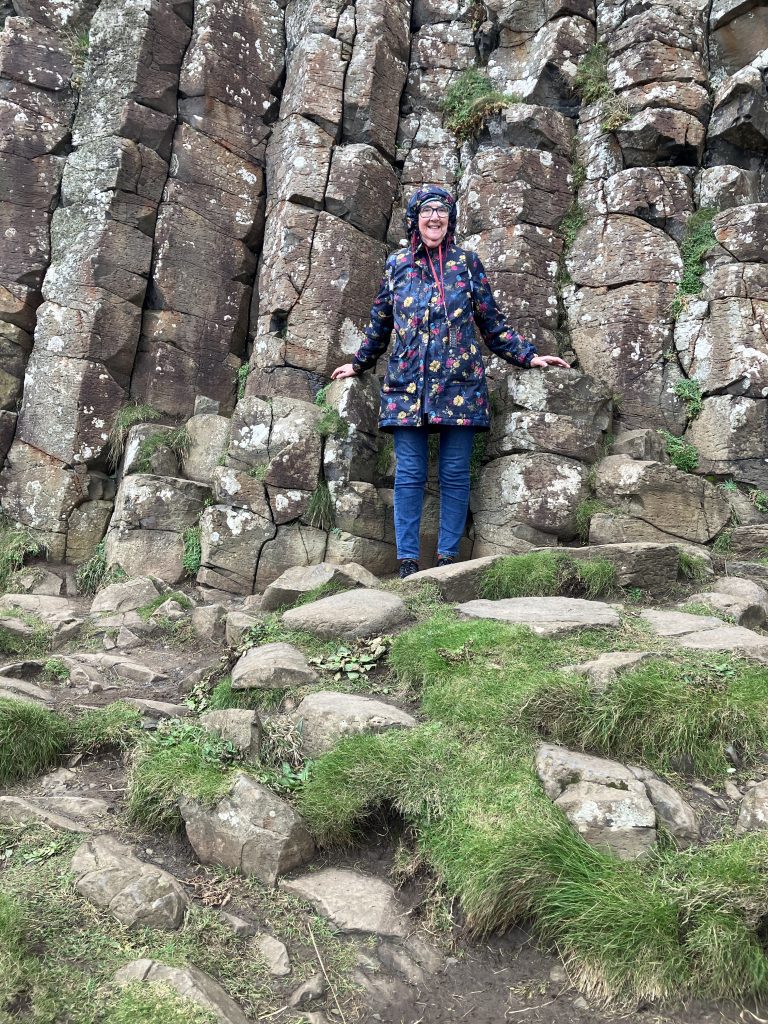
Then was back to the coach at 5 for our 45 minute trip back to The Lodge Hotel. I went for a drink in the bar before dinner, trying out an Irish cider. We’d decided to change tables which caused the serving staff much consternation but we succeeded in the end and our new table companions were much easier to converse with. My starter was peach stuffed with cream cheese – not a combination I’ve had before but it was delicious. The vegetable pasta, on the other hand, was dreadful – a huge dish in which everything tasted of tomatoes. I finished the evening writing my journal whilst watching another episode of Ant and Dec’s Limitless Win!
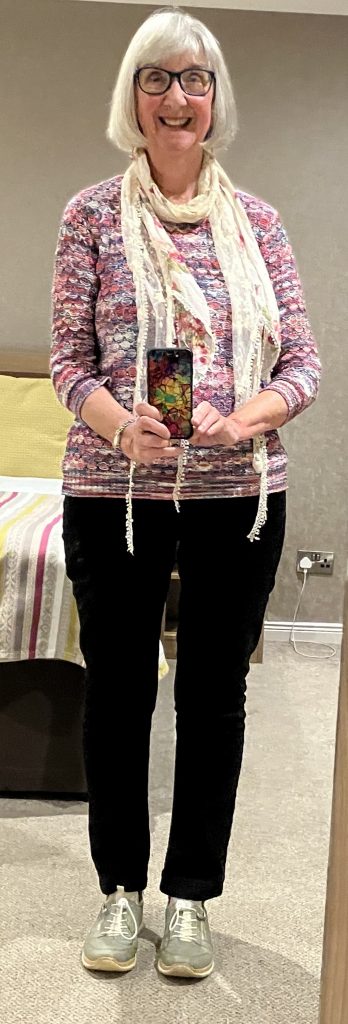
DAY 4
As I crossed the courtyard for my 8.45 breakfast I was pleasantly surprised to see some sunshine peaking through the clouds. It was hour and a quarter’s drive to Glenarm through an area of County Antrim that is designated an area of outstanding natural beauty with its lovely coast and glens. I remarked again on the lack of walls which had formed such a feature of my travels through south west Ireland. Here the fields are divided by neat hedgerows, mostly beautifully trimmed. The maintenance of these hedges must be very time consuming.

We were booked to take a tour of Glenarm Castle, home of the McDonnells, earls of Antrim and their family, though now it’s mainly used as a summer home or occasional retreat since the family live primarily in London but it wasn’t too long ago that the family entertained Charles and Camilla in the castle. Because it is still a family home it has very limited open days.


First of all we explored the walled gardens, dating from the 17th century, which reminded me in some aspect of Monet’s garden in Giverny with its straight paths all set at right angles to each other. The ‘castle’ itself is rather an odd building. It was built on its present site by Randal MacDonnell, 1st Earl of Antrim in 1636. However only six years later, in 1642, the house was burned by a Scots Covenanter army who were attacking the royalist MacDonnells and so it remained a roofless ruin for ninety years. In 1756 the 5th Earl of Antrim invited an engineer from Cumbria called Christopher Myers to come to Glenarm to rebuild the ruin.
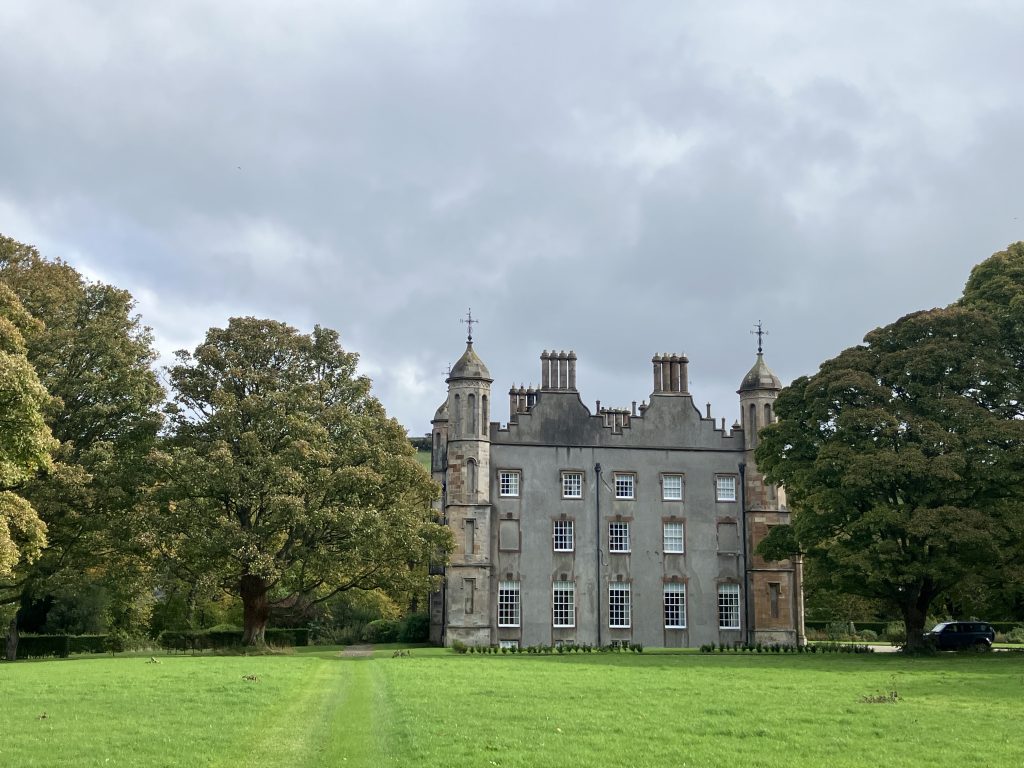
Myers transformed it into a grand Palladian country house with curving colonnades ending in pavilions on either side, one of which contained a banqueting room. In 1799 Ann Catherine married Sir Harry Vane-Tempest, who decided to ‘Gothicise’ the building. The colonnades and pavilions were demolished and Gothic windows installed. In 1929 a fire gutted the main block. It is believed to have been caused by the housekeeper’s bedroom fire, which she kept going to keep the 11th Earl’s featherless parrot warm. However, in 1934 Randal, 13th Earl of Antrim, married Angela Sykes a professional sculptor, and under the guidance of the author Robert Byron she started sculpting nine planets as caryatids in the hall. She subsequently turned her attention to other rooms of the house, painting walls and cornices with her interpretations of family history and classical mythology. I thought these were absolutely grotesque, so much so that they looked ridiculous to my eyes. Our tour guide is the current family butler so this made the tour extra special.

We were able to sit at the family’s dining table where Charles and Camilla had been entertained. We weren’t able to view the bedrooms – too private. As our tour group made its way back into the garden I asked our guide if I could possibly play the piano and I was surprised that I was told I would be most welcome. It was a Steinway grand but two of the keys were sticking badly. Angela Sykes was the daughter of Sir Mark Sykes, 6th Baronet of Sledmere and yes – I’d played the piano at Sledmere on a visit in June 2022. Unfortunately we weren’t allowed to take photos inside the building today.

Amongst the outbuildings was a wood engraving workshop called The Dribbly Yak. As I bought a card for Rachel’s birthday featuring a laser cut violin I chatted to the owner. He and his wife, both wood workers, had uprooted from Belfast last year to set up the business at Glenarm.


We had half an hour to explore the beach which was only a couple of minutes walk from the castle. I brought a few beach pebbles back with me to add to my collection. It took us a couple of hours to drive back to the Lodge Hotel and then Shirley and I played a game of Set before dinner in the Vibes bar over a glass of Irish cider. Shirley hadn’t heard of the game before, and neither had the people sitting on the adjacent table who asked us about it. Is it an American game? Dinner at 7 pm was an entree served with yet more dishes of mashed potatoes and chips and boiled veggies. We had been promised ‘entertainment’ after dinner but it was just a man selecting recorded music – hardly my idea of ‘entertainment’ but I’m probably comparing it with my cruise where there was always at least three live acts on each evening. Apparently I live singer came into the dining room later in the evening but we weren’t to know that and we’d already left by the time he took the floor.

DAY 5
Today we were left to our own devices. Shirley and I had decided to go into Belfast by train. We were puzzled that our itinerary didn’t include a visit to the city. We walked into Coleraine but didn’t see much of it as we made our way to the railway station.

It was an hour and a half’s train ride to Belfast. Someone had told us that it was a lovely ride but it was very much a duplicate of northern England with green rolling hills dotted by sheep and cows. We arrived at the new Transit station that’s only been open a year and headed straight to the Hop On Hop Off bus stop outside the imposing City Hall, alighting at the Titanic Experience. The building itself is amazing.

Constructed between 2009 and 2012 it was completed in time to commemorate the 100th anniversary of Titanic’s maiden voyage. I’d heard people complaining that they found the £26 entrance fee overpriced. Perhaps that’s because so many museums in Britain are free but I thought it was worth every penny – and more. I’d read that the average time spent by visitors is two hours but since there was so much to see in Belfast I thought I’d try and half that time. No way! I was totally captivated by all the displays and it included a ‘buggie ride’ and a glass lift to get to the top of the gantry.





The whole presentation is very poignant with the names of all those lost being stated on huge plaques along with artefacts that were subsequently recovered, and many stories about the passengers. The actual violin played by Titanic band leader Wallace Hartley was recovered from his body and later authenticated. It was found in a leather case that was strapped to his body and retrieved by a morgue ship. The violin was returned to Hartley’s fiancée and eventually ended up in a North Yorkshire attic, where it was discovered in 2006.
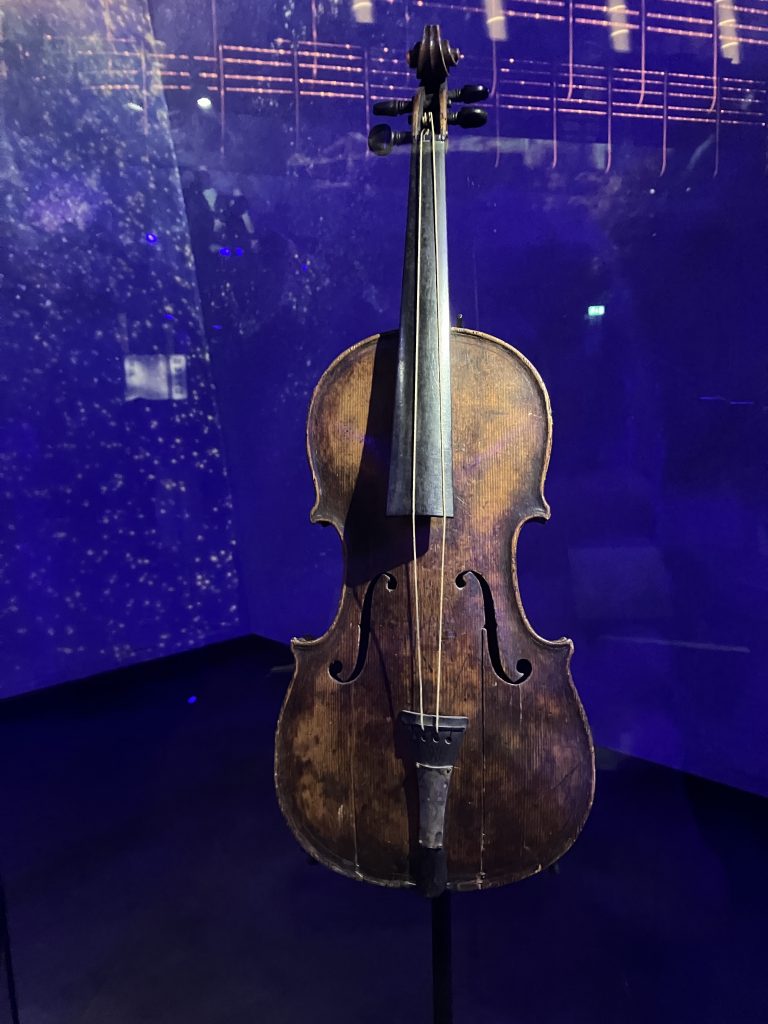
I could easily have spent an hour in the gift shop alone, so eventually two and a half hours later we emerged and made our way to the SS Nomadic which had been the tender transporting people from the Cherbourg dock to the Titanic itself. It was recently restored in 2010 after being abandoned for many years.
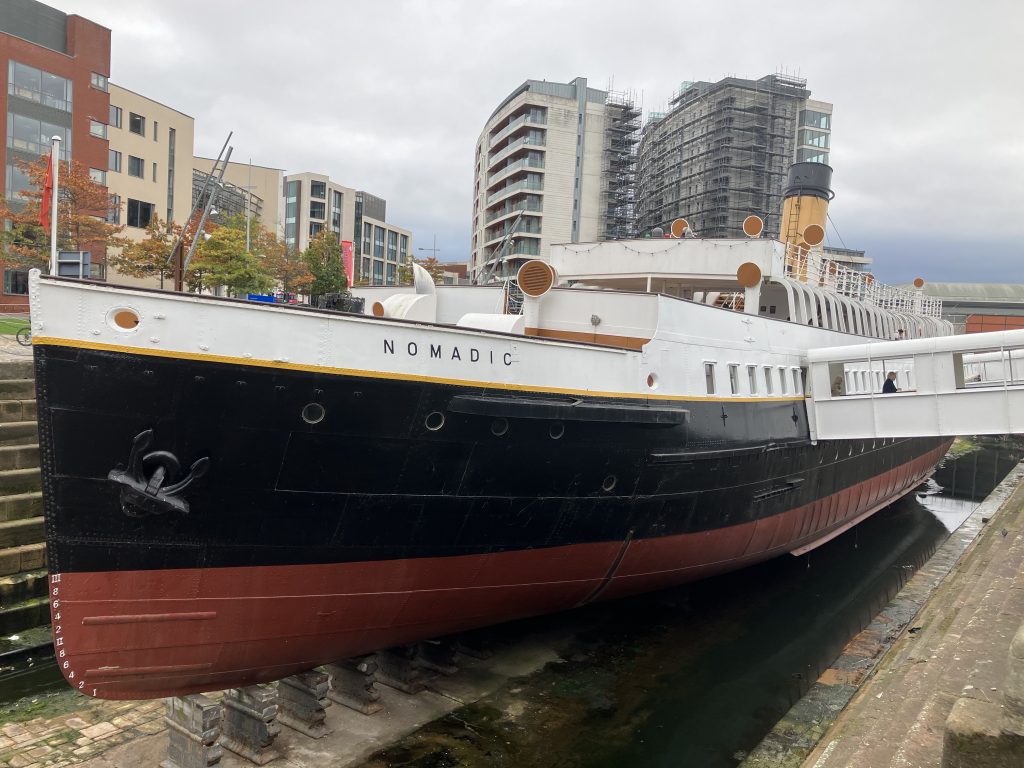
Then back on the Hop On bus for our visit to the Falls Road and Shankill Road areas of the city. The entire route of the bus takes 90 minutes so unfortunately I wasn’t able to hop off the bus to get a closer look at the walls that are now covered in art work but from the top deck of the open top bus I was able to get a good view, despite getting extremely cold. There was an excellent guide on the bus. The Shankill Road is a predominantly Protestant area of Belfast, historically associated with the city’s unionist and loyalist community.



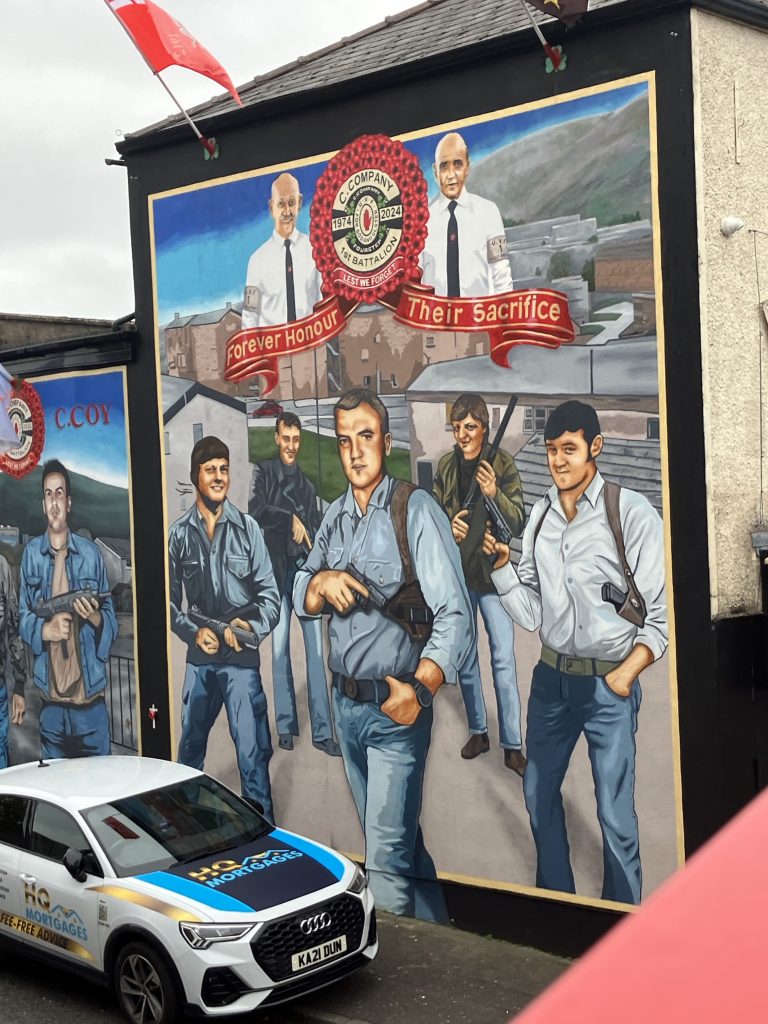
It is the counterpart to the Falls Road, which is a predominantly Catholic area, and the two communities were historically separated by peace walls, especially during the height of the Troubles. I was surprised to learn that one gate in the Shankill and Falls road is still closed at 18:00 every day.
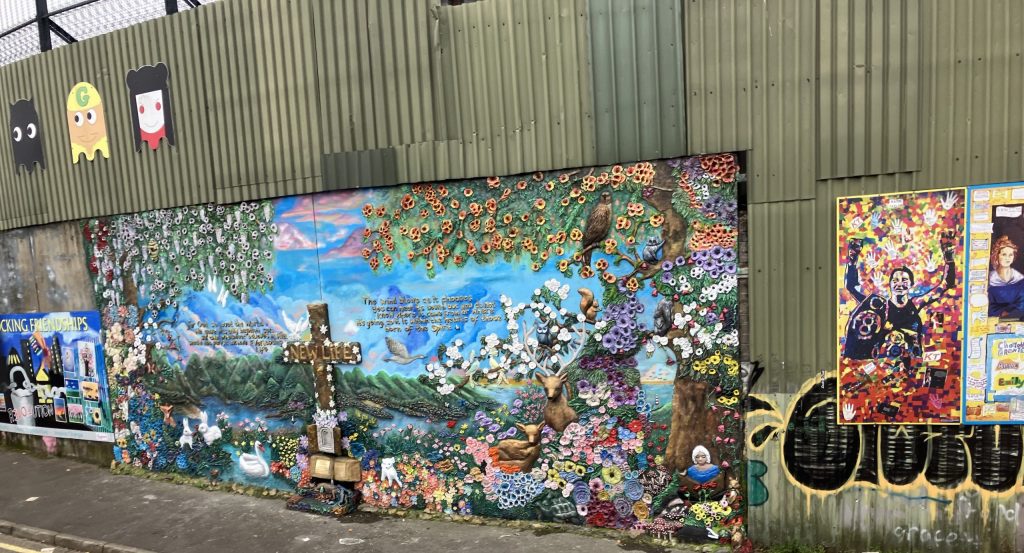
We drove past the famous Crumlin Road Gaol which is known as Europe’s Alcatraz because of the well known political prisoners who were held there including Bobby Sands whose mural we saw. Today the prison is a museum and
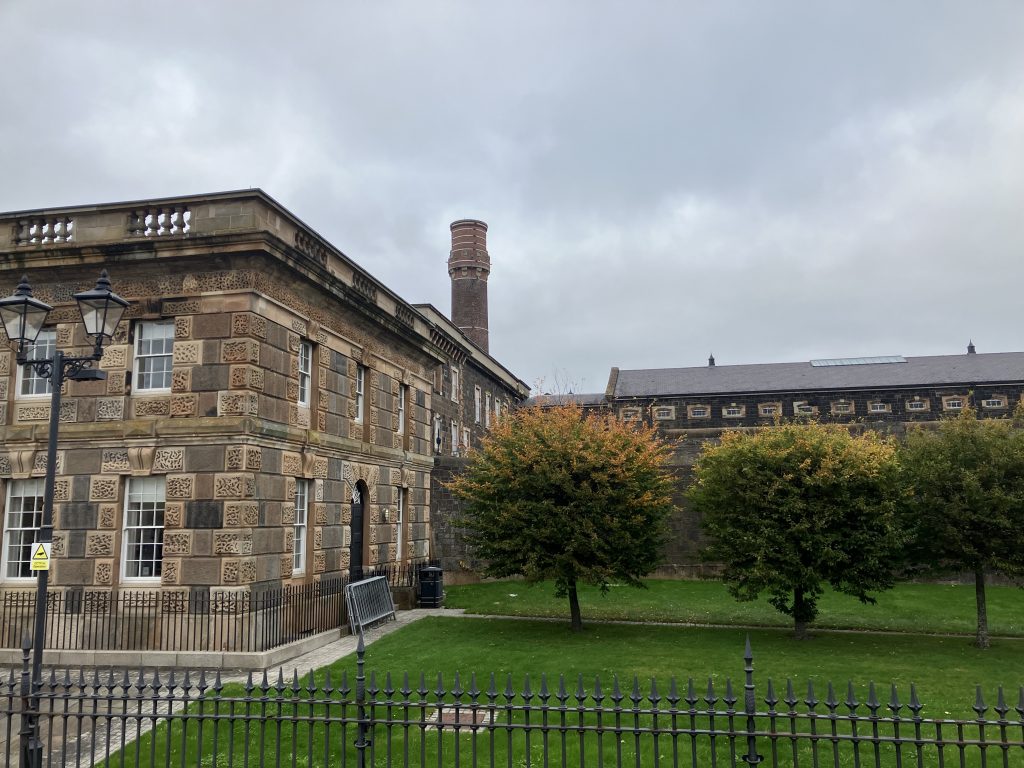
visitors’ centre. I also caught a glimpse of the facade of Queen’s University which reminded me so much of my old school – Bolton School.
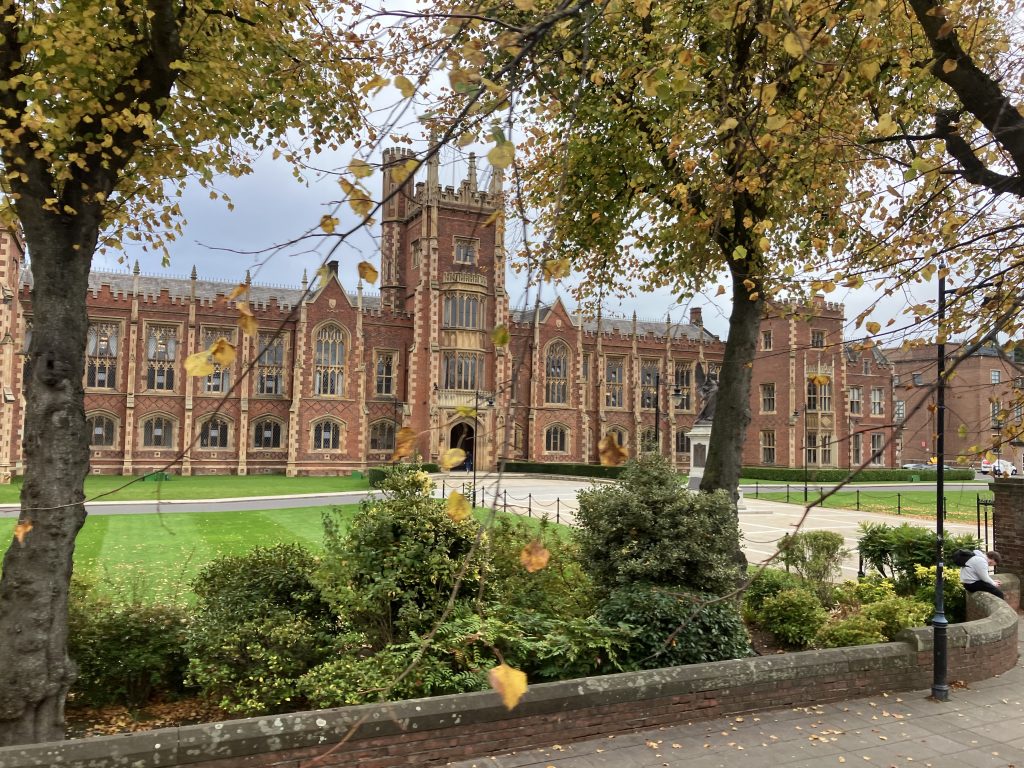

On our way back to the railway station we passed the imposing building of the opera house which opened in 1895. According to the Theatres Trust the “magnificent auditorium is probably the best surviving example in the United Kingdom of the oriental style applied to theatre architecture”.

I’d love to have been able to go and have a look inside and watch a show, but time beckoned and we caught the 4.35 train back to Coleraine, walked back to the hotel and arrived there at 6.30, perfectly timed for dinner at 7pm. My salmon was delicious. I presume it is locally sourced. The entertainment tonight was ‘live’ and consisted of two men playing penny whistles. Although they were adept at playing their instruments it seemed rather odd to play every piece in unison! The music was interspersed with a few jests and jokes. We stayed for half an hour or so and then made our way back to our rooms to pack for our departure the following morning.
DAY 6
After our very early start on the first day of our tour I was surprised that we weren’t setting off for our long journey home until 9.30a.m. I had to put my suitcase outside my room before going down to breakfast so that it could be placed back on the coach. It had come to my notice that I was always the last one back on the coach – but never after our scheduled time!
So I waved bye bye to The Lodge Hotel and off we set. It was a 90 minute drive back to Cairnryan port through gentle green fields and then two hours on the ferry. This time it wasn’t quite as windy as on our initial crossing.
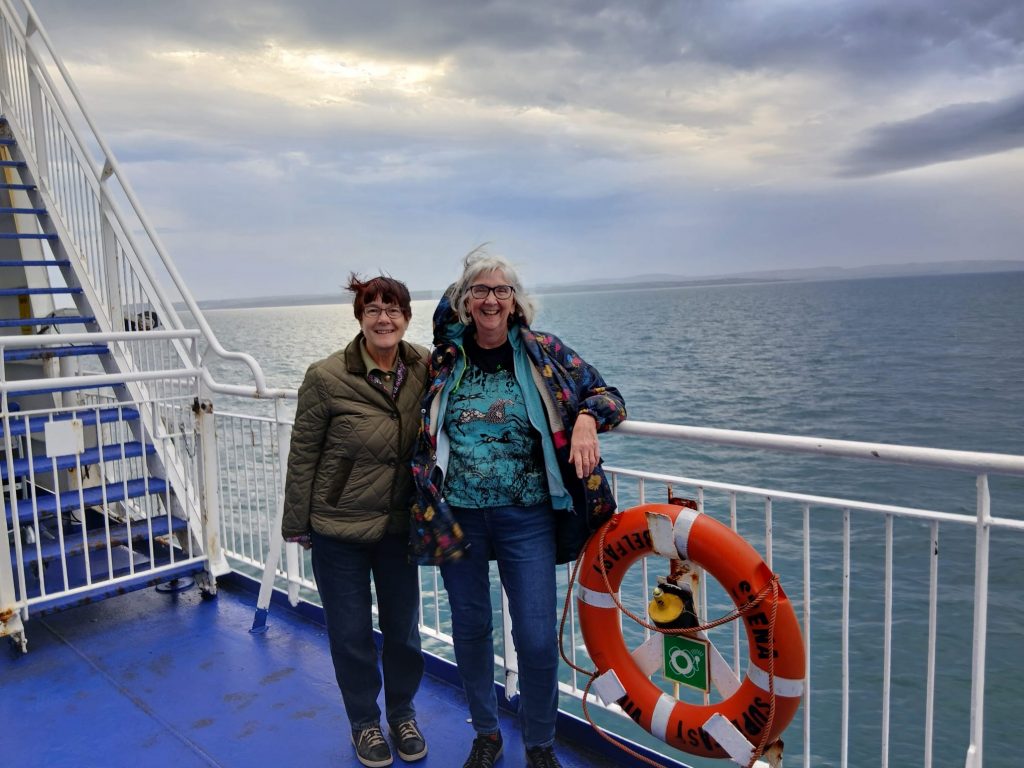
I had a snack on the boat since our scheduled ‘lunch’ would be 4 o’clock at Gretna Green. I don’t think I’ve been there before. I certainly didn’t recognise the sculptures in the gardens there.

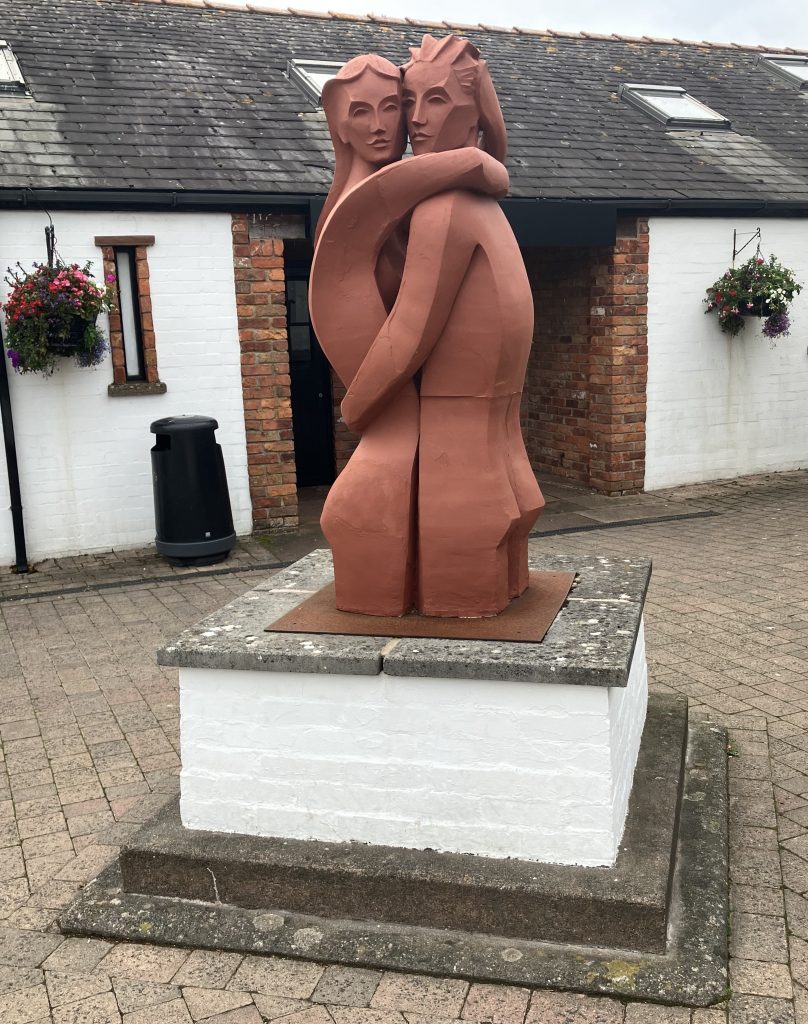

Then it was only just over two hours to Blackburn. That really surprised me. I’d always thought of Scotland being 4 hours away from where I live. I anticipated chaos as we parked back at the Hampton Hotel, with everyone having to wait for their luggage to be unloaded from the coach and then finding the taxi that had been assigned to them. But no, within 5 minutes of the coach stopping I was in the taxi and being whisked back to Hebden Bridge, arriving at 8.31 where a waiting kitty was eager to welcome me back.

A ‘nice’ tour of Northern Ireland
Leave a Reply